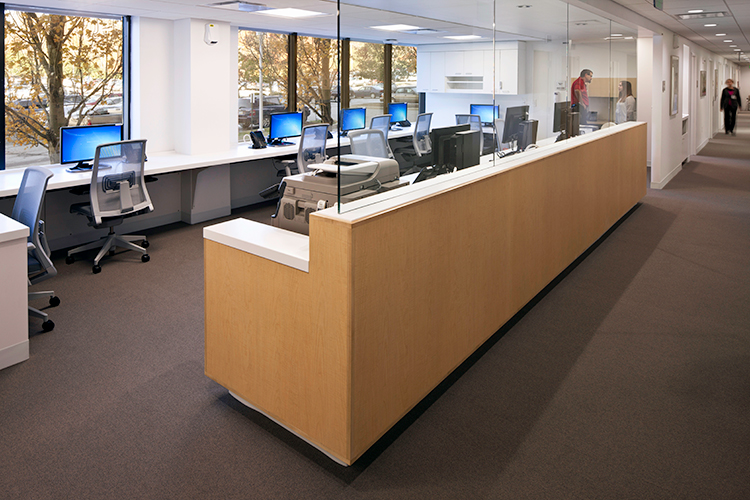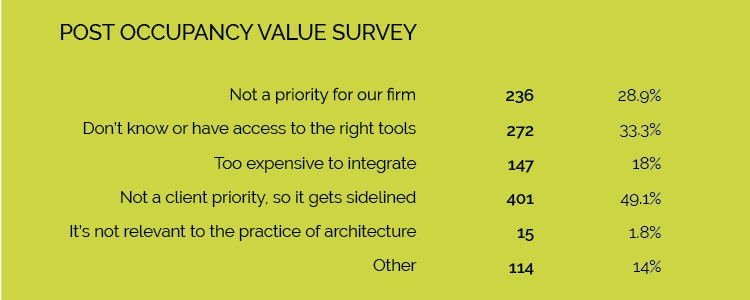An Argument for the Post Occupancy Phase
Clients and architects alike are familiar with the traditional phases of project delivery. The project often starts out with programming and planning, proceeds into schematic design, then design development, then construction documents, and is considered complete after construction administration. That final phase is usually the architect’s last contribution to the project. They work throughout this phase with the contractor to translate the building from an idea to a structure before releasing the final building into the hands of the occupants.

But After Construction Administration… Then What?
A work of architecture is a story, and in order to write it, architects use the design development phase to engage the users that occupy the space. With the foundation of the schematic design phase in place, users can contribute their thoughts on more intricate details, like the placement of equipment and the layouts of rooms.
Architects play the role of leading the client through this pivotal phase, as the clients are the protagonists of the story. In the example of a healthcare project, the objective of the architect is to put him or herself into the shoes of a nurse or a patient that would move through the space. Architects strive to understand the operational flow of the building’s staff and visitors, with the awareness that the end users will be experiencing that space on an intimate level. Our role is to translate their desires into detailed drawings.
Once construction documents are in place, architects are involved in construction administration, after which they typically retreat from the project. However, construction administration is not “the end.” In fact, it serves more as a climax during which drawings are transformed into a physical being, and architects are challenged to ensure the concepts they and the clients agreed on are conveyed to the builders correctly. The story is not over until the users inhabit the space, live and breathe it, and get to know it. And if the building is a success in their eyes, then the narrative is complete.
One User's Story
Once the project ends, architects do not stop caring. Each story that we write has the chance to provide an important contribution to the organization’s next endeavor. As an architect, I feel the building should not be left to the archives after occupancy – especially since tying up the loose ends of the story can benefit the client. Architects should be given the opportunity to complete their role as storytellers and provide their services to the end.
Last year, at the Healthcare Design Expo and Conference, I attended a session entitled Story Addict: Designing and Delivering Narrative, presented by Dr. Sheila Bosch. During the session, Dr. Bosch asked a friend and colleague of hers, Deborah Wingler, to share a story that no one in the room expected. As she spoke, she delivered a stark description about her young daughter’s experience with cancer. During those difficult days and weeks and months, Deborah spent long hours beside her daughter in a cold hospital room in a terribly uncomfortable chair. By the end of the story, the room was full of stunned designers, many of whom had not personally been touched by cancer, and most of whom had never considered that the selection of a simple bedside chair could leave such a lasting impression on those who sit in it.
That story stands out in my mind more than any new product I saw or any advance in healthcare I learned about at the conference. It is the architect’s responsibility to make sure no parent suffers like the storyteller did, battling the space she was confined to while trying to focus on her daughter’s well-being.
Anecdotes such as this can shed light on our successes and failures after we release the building to its users. Without this kind of feedback, the story of the building is not complete.
If construction administration does not fulfill the story of the building, an additional phase could tie up loose ends. Post Occupancy, if it were to become a standard phase of the architectural project, would allow users to share their opinions.

A Client That Cares
Recently, we revisited Cleveland Clinic’s Medina Medical Office Building, a project DesignGroup completed three years ago. We walked their space with several of their medical staff in the hopes of gaining an understanding of what was working well in their new space and what was not. Our team prepared detailed questions in advance, and as we walked the space, the Cleveland Clinic nurses had the opportunity to discuss any nuances they had experienced. Through our conversations, we learned information that would help improve our practice. For instance, staff conveyed they do not use the laptops provided in each exam room because doing so would mean they would face away from the patient. In addition, their physicians are more accustomed to having their own offices rather than “hoteling” at workstations. We learned the printer alcoves we designed throughout staff areas made it easier for nurses to be productive and the amount of natural light that filtered into the space allowed users to shut off artificial light and enjoy sunlight. At the conclusion of our visit, we were enriched with a variety of information we can now use to enhance our future MOB designs and continue to improve Cleveland Clinic’s model.

Cleveland Clinic was willing to make the time and financial investment to allow us to survey their staff and continue their organization’s progress. Of course, implementing a new phase takes money and resources one may not immediately jump to spend. Former architect and current Invention Director at DeutschLA, Christine Outram, conducted a survey of architects to dissect the reasons post occupancy surveys are not commonplace. Shockingly, nearly half of the architects surveyed stated post occupancy surveys were not a client priority.

To Be Continued
The work and cost of the post occupancy phase is far outweighed by the continuous improvement that can be gained and replicated across the system. When a client sees value in conducting post occupancy work, architects are given the opportunity to complete the story of the building and continue its legacy into the next project. Post occupancy allows the users to share their opinions and successes. The main characters provide their narratives so we storytellers can write an even better story the next time around.
Now, I’ll correct and improve on what I said. Post occupancy isn’t exactly “the end” – it’s more like a “to be continued.”

Yana Grinblat // Project Architect
Yana brings a fresh perspective to design to her position as Project Architect. Trained in architecture, she offers a do-it-all approach with her passion for interior spaces. Her interest lies in the most minute details and sensitive moves that bring out emotion. Yana is particularly interested in healthcare architecture, she strives to advance the field and hone her expertise in crafting spaces that offer comfort and inspire celebration.
